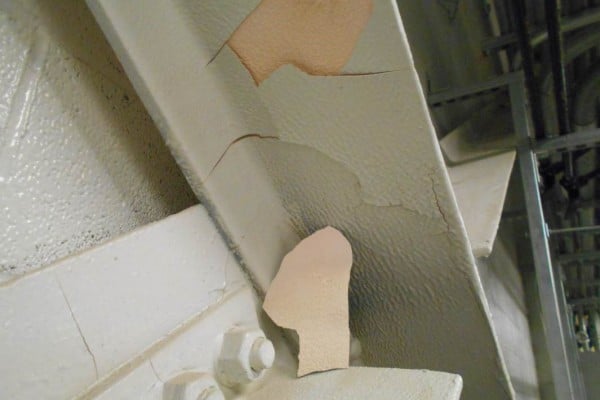INTUMESCENT PAINT TO STRUCTURAL STEEL
In this Bitesize CPD we will be looking at defects in the application of Intumescent paint to structural steel.
These are the most common defects picked up by FCM’s Clerks of Works during their site inspections.

Incorrectly applied intumescent paint delaminating from a structural steel member.
Intumescent coating products are designed to passively protect substrate materials—typically steel—from reaching combustion temperatures. These coatings function by charring and “swelling” upon exposure to high temperatures such as when a fire occurs. The charred coating then acts as an insulating layer to slow heat transfer to the substrate. A coating’s performance is rated in terms of hours, which indicates how long the coating can adequately protect the substrate.
Intumescent paint only partially sprayed onto un-primed, rusty and dirty steel beam.
In the photo above the operatives have sprayed the beam from ground level not expecting anybody to climb up and check for a full coating. This is very common and totally negates the reason for application. The beam could will fail during a fire with the possibility of building collapse. Shoddy workmanship is the most common cause for intumescent paint application being rejected by FCM’s Clerks of Works.
Secondly, the steel beam has been delivered to site with a light protective coating which has broken down and rust has started to cover the beam.
Most of the intumescent paints that are applied on site are water based and will require a full application of the specified primer to avoid delamination due to rust.
Rust showing through newly applied water based intumescent paint.
Manufacturers of these intumescent paints state in their application instructions that a primer must be applied to eliminate rusting and failure of the intumescent coating.
Concrete and mortar snots not removed prior to painting.
The steelwork must be free from dust and other deleterious material including oils, grease and concrete snots from the slab pours. Any foreign bodies on the steel must be removed and the primer must be touched up locally to cover any bare areas and and/or rust spots. Failure to correctly prepare the primer paint will result in long term adhesion problems. More importantly the manufacturer’s warranty for the paint will be compromised and may be withdrawn.
In order to achieve the specified fire protection, the intumescent paint has to be applied to the correct dry film thickness in microns. The thickness required will differ on each steel member depending on its size, shape and whether it is a supporting column or beam.
The film thickness of the intumescent is pivotal in ensuring the steelwork is adequately protected in the event of a fire. The HP/a factor of the steel aligned with the specified paint will determine the thickness of paint to be applied. This will be measured in microns (1000microns being equivalent to 1mm). Under application to the required thickness will result in premature failure of the steel in the event of fire, however, over application of intumescent can result in solvent entrapment and loss of adhesion and/or splitting of the primer. Over application can also cause the intumescent to run. The film thickness of the primer paint on the steelwork can also cause problems. Primer paint is applied to a nominal thickness of 75microns but over application (thicknesses over 120microns) can result in certain primers losing their matt finish and taking on a sheen/shiny finish. In many cases this sheen finish can prevent the intumescent adhering correctly to the primer, often this results in delamination.

Intumescent paint film with steel below ‘grinning’ through.
Often the intumescent paint is just sprayed or brushed on with no regard to the manufacturers thickness requirements. This often shows up as the steel ‘grinning’ through the coatings. As a rule of thumb the intumescent paint should look like a solid glassy finish rather than a rough and patchy one.
The paint should be checked during application for wet film thickness so that when it is dry it achieves the correct dry film thickness.
Watch the short video below for further information on causes of failure.
Steve Farrell
T: 07714234380
E: stevefarrell@fcmltd.co.uk
L: linkedin.com/in/stevefarrellfcmFox Curtis Murray are a building consultancy specialising in providing Clerks of Works services and Quality Control inspections.
- Subscribe to Our Newsletter


